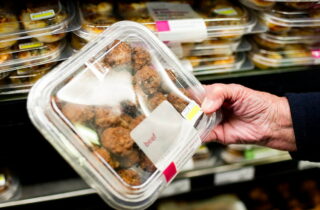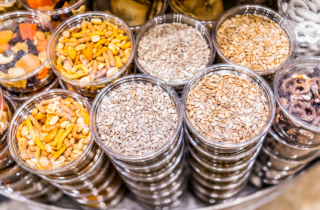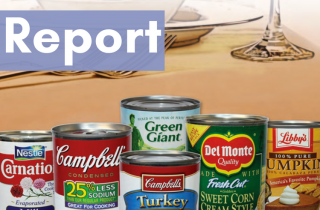BPA Laws and Regulations
At a Glance
Bisphenol A (BPA) is a hormone-disrupting chemical used in products such as soft and hard plastics, food packaging like food cans and bottle tops, re-useable food and beverage containers, thermal cash-register receipts, eyewear, dental sealants, and water pipe liners. We get most of our exposure to this chemical by eating and drinking.
BPA is commonly used in epoxy resin linings metal food cans to form a barrier between the metal and the food, leaching into the food and ending up in our bodies.
State and Local Regulations
State legislation to more strictly regulate BPA in food packaging was first introduced in 2005 in California. Since then, more than 30 states and localities have introduced policies to ban or restrict BPA.
Minnesota was the first state to pass a ban on BPA in any product in 2009, with Connecticut following soon afterward. In total, thirteen states have adopted 19 policies to regulate the use of BPA in consumer products. Those states have adopted policies regulating BPA in baby bottles and sippy cups (a “sippy cup” is defined by the FDA as a spill-proof cup, including its closures and lids, designed to train babies or toddlers to drink from cups). A few states have eliminated BPA in infant formula cans, baby food jars, sports water bottles, and even thermal receipt paper. In addition, four counties (Albany, Schenectady, and Suffolk in New York, and Multnomah in Oregon) and Chicago have also adopted policies to regulate BPA in food packaging.
In 2015, the California Office of Environmental Health Hazard Assessment (an agency of CalEPA) listed BPA as toxic to female reproduction. The chemical is subject to regulation by California’s Prop. 65, which requires consumer products that contain BPA to carry a warning label if levels exceed a “safe harbor” level. In 2020, the California Office of Environmental Health Hazard Assessment added developmental toxicity to the BPA listing. Under standard Prop. 65 warning procedures, each product containing BPA should be labeled as such, either on the product label or on signs in the shelf area where consumers are making purchasing decisions. An exception for BPA existed between 2015 and the end of 2017: Instead of labeling individual cans (or other products), a retailer could post a generic sign at the check-out stand stating that some canned and bottled products may contain BPA. During that time, manufacturers were also required to report food packaging made with BPA to a publicly accessible database.(1)
As of Jan 6, 2017, the temporary regulation issued by CalEPA allowing for point-of-sale warnings for bisphenol-A exposures expired. The state no longer considers it an option for businesses seeking to establish a safe harbor level for BPA in food or beverage packaging.
Federal Regulations
Food & Drug Administration (FDA)
In response to a food additive petition filed by the American Chemistry Council, the FDA banned BPA from baby bottles and sippy cups as of December 2012. A subsequent citizen petition filed by then Rep. Edward Markey (D-MA) prompted the FDA to ban BPA in infant formula packaging in 2013. The agency amended the existing regulations to disallow the use of BPA in baby bottles, sippy cups, or infant formula packaging to reflect their assessment that the industry has already abandoned the use of BPA in these items. However, it’s important to note that the FDA ruled based on industry-claimed market abandonment, not safety.
In 2014, the FDA estimated the then-current exposure of the U.S. population, which they identified as 200 nanograms per kilogram of body weight per day. Since then, the FDA has continued to state that this level of exposure is safe, even though independent academic research shows that it impacts the brain, prostate, urinary tract, ovary, mammary gland, and heart.(2) The FDA’s prior assessment of BPA in 2008 was rejected by its own Science Board because it excluded studies by independent scientists and relied on ‘regulatory toxicology’ or so-called guideline studies.(3) The independent academic studies provide much evidence for the harmful effects of BPA, and FDA has continued to exclude these academic studies from its evaluation of BPA.(4) This blinkered approach stands in contrast to the European Food Safety Authority’s recent report, which resulted in a radical revision of the European safety level (see International Regulation below).(5)
The FDA has also shown predictable inertia in not responding to the petition several NGOs and scientists submitted to change the BPA safety level. In May 2022, BCPP joined with Environmental Defense Fund, Clean Water Action/Clean Water Fund, Consumer Reports, the Endocrine Society, Environmental Working Group (EWG), Healthy Babies Bright Futures (HBBF), EDF consultant Dr. Maricel Maffini, and Dr. Linda Birnbaum, former director of the National Institute of Environmental Health Sciences and National Toxicology Program and petitioned the FDA to reconsider the safe level of BPA which applies here in the US.(6) While the FDA agreed to consider the petition, it has yet to respond, though the 6-month deadline was October 2022.
Congressional Actions
Past bills to regulate BPA include bills by Senator Feinstein and Senator Markey in 2015 and 2016. In 2015, Sen. Dianne Feinstein (D-Calif.) introduced S. 821, the BPA in Food Packaging Right to Know Act, which would have required labeling all canned food containing BPA. The bill directed the Department of Health and Human Services to re-review the safety of BPA, taking into account low-dose exposures, aggregate exposures, and potential adverse effects of exposure on vulnerable populations. The bill also required food containers made with BPA to carry a label stating: “This food packaging contains BPA, an endocrine-disrupting chemical, according to the National Institutes of Health.”
The Ban Poisonous Additives (BPA) Act of 2016 was introduced into both chambers of Congress by Sen. Edward Markey, D-Mass. and Rep. Grace Meng, D-N.Y. The bill aimed to empower the U.S. Food and Drug Administration (FDA) to remove BPA from food packaging, label food packaging that still contains BPA while alternatives are developed, encourage manufacturers to replace this hazardous chemical with safer alternatives and require the agency to review the safety of thousands of food contact substances. The bill also directed the Food and Drug Administration to periodically review the list of other substances considered safe in food and beverage containers to determine whether new scientific evidence raised concerns that the substance posed adverse health risks.
In 2023, Representative Jan Schakowsky (D-IL) introduced the No Toxics in Food Packaging Act, H.R. 6105, which would require the FDA to ban BPA in all food packaging and production materials. Take action to support the bill.
International Regulation
The momentum for restricting or prohibiting BPA (and other bisphenols) in food packaging is global.
In 2010, Denmark placed a temporary national ban on BPA in materials in contact with food for children aged 0–3 years (infant feeding bottles, feeding cups, and packaging for baby food). In 2013, Belgium banned the use of BPA in food contact materials intended for children up to age three. Austria banned BPA in pacifiers and teething devices. France banned the use of BPA in all food containers as of 2015 and infant food packaging as of 2013. Before this, several French cities banned baby bottles made with BPA in city nurseries and daycare centers. The national bans were all temporary measures to be upheld or rejected centrally by the EU under its EU-wide Food Contact regulation process.
The European Union banned the use of BPA in baby bottles and sippy cups in 2011 (Directive 2011/8/EU). In 2015, the European Food Safety Authority (EFSA) published a re-evaluation of BPA exposure and toxicity.
At that time EFSA set a temporary safety level – a Tolerable Daily Intake level (TDI)(7) of 4000 nanograms or four micrograms per kilogram of body weight per day (abbreviated as ng/kg bw/d or µg/kg bw/d) for BPA.(8) EFSA planned to revise its assessment after the results of the groundbreaking new CLARITY BPA series of studies (2013 – 2019) were completed.(9)
In 2017, EFSA started its re-assessment work, conducting a public consultation about and then developing, publishing, and testing a scientific protocol for the methodology it would use to re-evaluate BPA.(10) It then conducted the assessment, put out its draft report in November 2021, held another public consultation, met with stakeholders, EU member states, and the U.S. FDA to discuss the draft report, and issued a final scientific opinion in April 2023. That final report says a safe level of exposure to BPA is 0.2 ng/kg bw/ day, a 20,000-fold decrease from their 2015 level.(11) Less than one year later, in February 2024, the European Commission published a draft regulatory proposal to ban bisphenol A and other bisphenols in food contact materials again with a public consultation.(12) The proposal bans the use of BPA in plastics, varnishes and coatings, printing inks, adhesives, ion-exchange resins and rubbers. Other bisphenols that are classified in the European system as carcinogenic, mutagenic (affects DNA), toxic to reproduction, or hormone disrupting for human health are also banned in this proposal. The proposal also requires companies to monitor for the presence of BPA in and potentially migrating from: 1) materials that have varnishes and coatings made of a structurally similar chemical called BADGE, 2) polysulfone resins for use in filtration membranes; and 3) paper and board materials and articles containing recycled material.
In contrast, here in the U.S., the FDA has still not responded to a petition submitted by a group of NGOs in May 2022 to change the safe level of BPA.(13)
References
[1] See https://oehha.ca.gov/proposition-65/qa-new-reporting-requirements-businesses-using-point-sale-safe-harbor-warning-bpa
[2]See Vom Saal F et al., 2024. The Conflict between Regulatory Agencies over the 20,000-Fold Lowering of the Tolerable Daily Intake (TDI) for Bisphenol A (BPA) by the European Food Safety Authority (EFSA), Environmental Health Perspectives Vol 132 (4): https://doi.org/10.1289/EHP13812
[3]Vom Saal FS, Vandenberg LN. 2021. Update on the health effects of bisphenol A: overwhelming evidence of harm. Endocrinology 162(3):bqaa171, https://doi.org/10.1210/endocr/bqaa171.
[4]FDA.2008. FDA Science Board Subcommittee Report on Bisphenol A. https://graphics8.nytimes.com/packages/pdf/health/29bpa.pdf See the discussion of the CLARITY BPA study: Vom Saal F et al., 2024. The Conflict between Regulatory Agencies over the 20,000-Fold Lowering of the Tolerable Daily Intake (TDI) for Bisphenol A (BPA) by the European Food Safety Authority (EFSA), Environmental Health Perspectives Vol 132 (4) https://doi.org/10.1289/EHP13812
[5] Having said that, risk assessments with their calculations of ‘Risk Characterization Ratios’ have been the subject of many critiques that point to biases in the type of data used; including gaps in solid evidence about actual exposures. See for example, Making Better Environmental Decisions: An Alternative to Risk Assessment, O’Brien, 2000.
[6] Specifically this is a Food Additive Petition submitted to the FDA, asking it to limit dietary BPA exposure by revoking approvals for BPA use in adhesives and can coatings and to set strict limits on BPA use in food contact plastics.
[7]The Tolerable Daily Intake estimates how much a person can be safely exposed to every day over a lifetime, (via air, food or drinking water) over their lifetime, without no appreciable increase in risk to their health.
[8]2015 European Food Safety Authority ‘Scientific Opinion on the risks to public health related to the presence of bisphenol A (BPA) in foodstuffs’ https://doi.org/10.2903/j.efsa.2015.3978
The scientific panel did benchmark dose response modelling (BMDL10) for “likely” adverse effects in animals, but could not calculate a BMDL for mammary gland effects. The Panel applied a total uncertainty factor of 150 (for inter- and intra-species differences and uncertainty in mammary gland, reproductive, neurobehavioural, immune and metabolic system effects) to establish a temporary Tolerable Daily Intake (t-TDI) of 4 μg/kg bw per day.
[9] The outcomes of the CLARITY-BPA research is its own saga. Useful publications are:
Articles in Environmental Health News about Clarity, for example: the five part series: https://www.ehn.org/is-bpa-dangerous-for-health-2641153205.html
and the more recent 2022 article: https://www.ehn.org/bpa-efsa-fda-2656541533/clarity-on-bpa-elusive-in-u-s
Heindel JJ, et al., Data integration, analysis, and interpretation of eight academic CLARITY-BPA studies. Reprod Toxicol. 2020 Dec;98:29-60. doi: 10.1016/j.reprotox.2020.05.014. Epub 2020 Jul 16. PMID: 32682780; PMCID: PMC7365109. https://pubmed.ncbi.nlm.nih.gov/32682780/
Vandenberg LN, Hunt PA, Gore AC. Endocrine disruptors and the future of toxicology testing – lessons from CLARITY-BPA. Nat Rev Endocrinol. 2019 Jun;15(6):366-374. doi: 10.1038/s41574-019-0173-y. PMID: 30842650.
Vom Saal FS, Vandenberg LN. Update on the Health Effects of Bisphenol A: Overwhelming Evidence of Harm. Endocrinology. 2021 Mar 1;162(3):bqaa171. doi: 10.1210/endocr/bqaa171. PMID: 33516155; PMCID: PMC7846099.
[10] See https://www.efsa.europa.eu/en/topics/topic/bisphenol
[11] April 2023, EFSA press release https://www.efsa.europa.eu/en/news/bisphenol-food-health-risk
EFSA Report: Re-evaluation of the Risks to Public Health Related to the Presence of Bisphenol A (BPA) in Foodstuffs https://www.efsa.europa.eu/en/efsajournal/pub/6857
[12] https://ec.europa.eu/info/law/better-regulation/have-your-say/initiatives/13832-Food-safety-restrictions-on-bisphenol-A-BPA-and-other-bisphenols-in-food-contact-materials_en
[13] Specifically this is a Food Additive Petition submitted to the FDA, asking it to limit dietary BPA exposure by revoking approvals for BPA use in adhesives and can coatings and to set strict limits on BPA use in food contact plastics.
Types: Article




